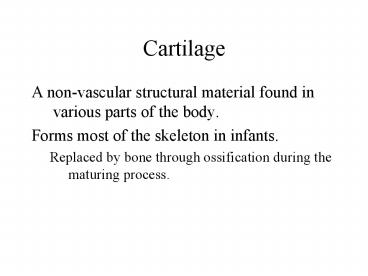Cartilage - PowerPoint PPT Presentation
1 / 25
Title:
Cartilage
Description:
Cartilage A non-vascular structural material found in various parts of the body. Forms most of the skeleton in infants. Replaced by bone through ossification during ... – PowerPoint PPT presentation
Number of Views:722
Avg rating:3.0/5.0
Title: Cartilage
1
Cartilage
- A non-vascular structural material found in
various parts of the body. - Forms most of the skeleton in infants.
- Replaced by bone through ossification during the
maturing process.
2
Cartilage Classified by Its Change During
Maturation
- Temporary Cartilage Cartilage which is
naturally replaced by bone during ossification. - Permanent Cartilage Cartilage which is designed
to remain largely unossified throughout life.
3
Types of Cartilage
- Hyaline Cartilage
- Elastic Cartilage
- Fibrocartilage
4
TYPES OF CARTILAGE
- Hyaline Cartilage
- A gristly mass of firm consistency
- Considerably elastic
- Covered by a fibrous membrane called the
perichondrium which provides its source of
nutrition - PERICHONDRIUM NOT PRESENT IN ARTICULAR CARTILAGE
5
TYPES OF CARTILAGE (continued)
- Elastic Cartilage
- Yellowish in color
- More flexible or rubbery than other types of
cartilage - Contains elastic fibers imbedded in the cartilage
matrix
6
TYPES OF CARTILAGE (continued)
- Fibrocartilage
- A mixture of white fibrous tissue and
cartilaginous tissue - Flexibilty comes from the fibrous tissue
- Toughness comes from the cartilaginous tissue
7
TYPES OF FIBROCARTILAGE
- connecting fibrocartilage
- intervertebral joints (vertebral symphysis) and
pubic symphysis - adheres to opposing surfaces
- found in joints which admit only slight mobility
8
Vertebrae Cross Section
intervertebral discs
9
TYPES OF FIBROCARTILAGE (continued)
- interarticular fibrocartilage
- menisci of knee
- also found in temporomandibular,
sternoclavicular, acromioclavicular and wrist
joints - free on both surfaces - held in place by
ligaments - Found in joints subject to frequent movement and
high impact
10
Menisci Top View
11
TYPES OF FIBROCARTILAGE (continued)
- circumferential fibrocartilage
- labrum in shoulder and hip
- deepens the joint to increase stability and
contact area
12
Hip Cross Section
articular cartilage
pelvis
labrum
articular cartilage
femur
labrum
13
TYPES OF FIBROCARTILAGE (continued)
- 4. stratiform fibrocartilage
- forms a thin coating where tendons pass through
grooves in the skeleton - develops in the tendons of some muscles where
they glide over bones (examples Peroneus Longus
and Tibialis Posterior)
14
SITES OF STRATIFORM FIBROCARTILAGE
Right Leg Lateral View
Right Ankle Medial View
15
ANATOMICAL PRESENCE OF CARTILAGE
- JOINT CARTILAGE
- STRUCTURAL CARTILAGE
- ELASTIC CARTILAGE
- BONE CARTILAGE (TEMPORARY CARTILAGE)
16
A. JOINT CARTILAGE
- 1. Articular cartilage - surrounds ends of bones
at articulations - formed by hyaline cartilage
- assists in shock absorption - compression
- increases contact area
- low friction surface
- High in proteoglycans, some TypeII collagen
17
A. JOINT CARTILAGE (continued)
- 2. Fibrocartilage
- Assists in shock absorption
- Promotes a "tight fit in the joint
- Made of proteoglycans, Type I and II collagen
18
B. STRUCTURAL CARTILAGE
- Performs a supportive structure like bones
- Made of hyaline cartilage
- Costal cartilage (continuation of the ribs)
- Also found in nose, larynx, xiphoid process and
most of the trachea
19
Thoracic Skeleton
Costal Cartilage
20
C. ELASTIC CARTILAGE
- Shapes or supports structures needing flexibility
and elasticity - Found in external ear, Eustachian tube,
epiglottis and parts of the larynx
21
D. BONE CARTILAGE
- The temporary cartilage that ossifies during the
maturing process. - Largely responsible for the structural
differences between the bones of children and
adults. - Because of the high cartilage content, childrens
bones - have lower strength
- are less stiff
- have lower energy to failure
- have larger strain to failure
- are subject to greenstick fractures
22
Susceptibility to Injury
- Due to its lack of direct blood supply, cartilage
has very limited ability for repair. - Susceptible to "wear and tear" injuries
- Cushioning effect decreases with age
23
Joint Cartilage
- ANISOTROPIC (has different structural properties
in different directions) - High resistance to COMPRESSION
- NOT to tension or shear
- reduces stress by decreasing impact forces and
increasing area of contact
24
Synovial Fluid
- Secreted by synovial membrane
- Lubricant in freely moveable (synovial) joints
(i.e., reduces friction in joint while moving) - Not an oil! Composed of water, hyaluronic acid,
glycoproteins (lubricin) - Most effective with healthy cartilage
- The faster the joint is articulating (increased
angular velocity) the greater the lubricating
effect - Temperature dependent (Becomes less viscous with
increased temperature)
25
Basic Synovial Joint































